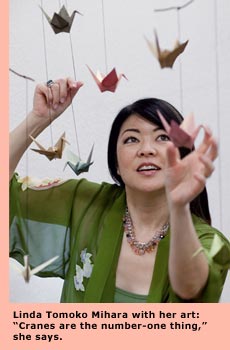Art in the Air - Page 4

Origami cranes take flightAre you seeking a long and prosperous marriage? One thousand cranes may be the answer. The cranes, cut from paper using the Japanese technique of origami (ori means 'to fold,' and gami means 'paper'), are often festive décor for weddings. Although origami creations are commonly displayed as static objects, they take to the air very well, says Linda Tomoko Mihara, a leading San Francisco origami artist. One thousand cranes are suspended from trees during a wedding so they can be viewed by the bridal party, she says. Mihara is best known for an amazing ability to create multiple three-dimensional images from a single sheet of paper. Mihara herself has created a number of mobile-like origami projects, including an American flag made of origami cranes that's hanging at the Smithsonian Institution, and a curtain of origami butterflies installed at Lear Automotive in Detroit. "Origami lends itself to the idea of a mobile or structure of mobiles," Mihara says. She enjoyed a photo taken by Ernie Braun [our cover this issue] of a child who seems enraptured by a flock of 1,000 suspended cranes. "The cranes are in flight," she said, "the wings are open." Recent Mihara projects have included origami crane mobiles for the rooms of newborn babies, and an origami crane installation for a private home in San Francisco. Mihara has done other hanging origami installations -- including one in which the origami forms the image of an American flag draped in front of Executive Order 9066 -- which ordered the internment of Japanese-Americans during World War II. It was shown at the Smithsonian American Art Museum. But when it comes to origami in general, she says, "it seems like the cranes are the number-one thing to do for mobiles." |
Looking for a mobile?Type 'mobile' into your favorite search engine and the siege begins. As mobile maker Julie Frith notes, "There are a lot of mobiles out there." They range from cute -- teddy bears floating above cribs -- to cheesy, to high art. Many resemble Calder. "A small portion of it is inventive," mobile maker Brian Schmitt says, "and a huge portion is reinventing a style that's been done for decades." If you're looking for a mobile, bear this distinction in mind: Some are made by people like Schmitt, who considers himself both an artist and a product designer and aims his work at 'normal people.' That means mobiles produced as multiples in the $100-$200 range. Many mobile makers provide their artworks for less. Other artists produce only one-of-a-kind works, often for specific sites. Brad Howe sells his residential mobiles for roughly $5,000 to $10,000. Mobiles can be bought in galleries and museum shops, at crafts shows, or online. For artists featured in this article: |
- « first
- ‹ previous
- 1
- 2
- 3
- 4




